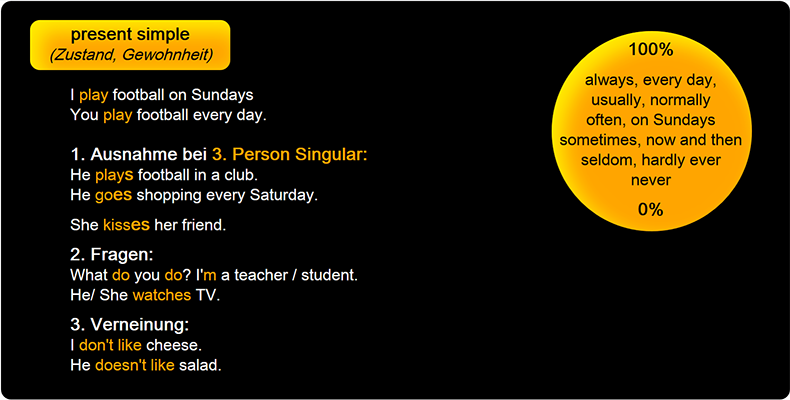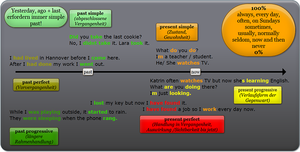Present Simple: Unterschied zwischen den Versionen
(kat) Markierung: Quelltext-Bearbeitung 2017 |
|||
| (11 dazwischenliegende Versionen desselben Benutzers werden nicht angezeigt) | |||
| Zeile 6: | Zeile 6: | ||
als SVG-Grafik: [https://wiki.zum.de/images/b/bd/Present-simple.svg Present Simple] | als SVG-Grafik: [https://wiki.zum.de/images/b/bd/Present-simple.svg Present Simple] | ||
__NOTOC__ | |||
== Bildung == | == Bildung == | ||
Im Simple Present wird das Verb meist nur in der Grundform verwendet. | Im Simple Present wird das Verb meist nur in der Grundform verwendet. | ||
=== 3. Person | === 3. Person Singular === | ||
In der <span style="color:red;font-weight:bold;">3. Person Einzahl</span> ('''''3rd Person singular''''') wird einfach ein -s | In der <span style="color:red;font-weight:bold;">3. Person Einzahl</span> ('''''3rd Person singular''''') wird einfach ein -s | ||
angehängt. | angehängt. | ||
Also bei: | Also bei: | ||
* <span style="display:inline-block;width:4em;">He</span> <span style="font-weight:bold;color:orange;background: rgba(255, 165, 0,.1);display:inline-block;width:3em;">plays</span> football. | |||
* <span style="display:inline-block;width:4em;">Mum</span> <span style="font-weight:bold;color:orange;background: rgba(255, 165, 0,.1);display:inline-block;width:3em;">works</span> in a bank. | |||
* <span style="display:inline-block;width:4em;">Peter</span> <span style="font-weight:bold;color:orange;background: rgba(255, 165, 0,.1);display:inline-block;width:3em;">bakes</span> a cake. | |||
* <span style="display:inline-block;width:4em;">The dog</span> <span style="font-weight:bold;color:orange;background: rgba(255, 165, 0,.1);display:inline-block;width:3em;">runs</span> after the cat. | |||
Dabei gibt es aber einige '''Ausnahmen in der Schreibweise''': | |||
'''Endung mit -y''': | '''Endung mit -y''': | ||
* Endet das Verb mit einem –y, wird statt des –y ein <span style="color:red;font-weight:bold;">–ies</span> angehängt. | * Endet das Verb mit einem –y, wird statt des –y ein <span style="color:red;font-weight:bold;">–ies</span> angehängt. | ||
:: ''I try the new clothes.'' | :: ''I <span style="font-weight:bold;color:orange;background: rgba(255, 165, 0,.1);">try</span> the new clothes.'' | ||
:: ''He tr<span style="color:red;font-weight:bold;">ies</span> the new clothes.'' | :: ''He <span style="font-weight:bold;color:orange;background: rgba(255, 165, 0,.1);">tr<span style="color:red;font-weight:bold;">ies</span></span> the new clothes.'' | ||
'''Endet das Verb mit einem Zischlaut oder einem -s,''' | '''Endet das Verb mit einem Zischlaut oder einem -s,''' | ||
* muss bei he, she, it ein <span style="color:red;font-weight:bold;">-es</span> angehängt werden: | * muss bei he, she, it ein <span style="color:red;font-weight:bold;">-es</span> angehängt werden: | ||
::''I wash my hands.'' | ::''I <span style="font-weight:bold;color:orange;background: rgba(255, 165, 0,.1);">wash my hands.'' | ||
::''He wash<span style="color:red;font-weight:bold;">es</span> his hands.'' | ::''He <span style="font-weight:bold;color:orange;background: rgba(255, 165, 0,.1);">wash<span style="color:red;font-weight:bold;">es</span></span> his hands.'' | ||
'''Ausnahmen''': | '''Ausnahmen''': | ||
* -es folgt auch bei den Wörtern ''do'' (tun, machen) und ''go'' (gehen): | * <span style="color:red;font-weight:bold;">-es</span> folgt auch bei den Wörtern ''do'' (tun, machen) und ''go'' (gehen): | ||
::''My father <span style=" | ::''My father <span style="font-weight:bold;color:orange;background: rgba(255, 165, 0,.1);">does</span> the cooking.'' | ||
::''Then he <span style=" | ::''Then he <span style="font-weight:bold;color:orange;background: rgba(255, 165, 0,.1);">goes</span> to work.'' | ||
=== Verneinung === | === Verneinung === | ||
In der Verneinung wird vor das Hauptverb das Hilfsverb '''''do''''' und '''''not''''' vorangestellt: | |||
:''I <span style="font-weight:bold;color:orange;background: rgba(255, 165, 0,.1);">do not</span> play football.'' | |||
Im Allgemeinen werden dabei die ''Short forms'' verwendet: | |||
:'' I <span style="display:inline-block;margin-left:2em;font-weight:bold;color:orange;background: rgba(255, 165, 0,.1);">don't play</span> football.'' | |||
:''Tim <span style="font-weight:bold;color:orange;background: rgba(255, 165, 0,.1);">doesn't play</span> basketball.'' | |||
Das Hauptverb bleibt dabei immer in der Grundform (''Infinitive''). In der [[#3._Person_Singular|3.Form Singular]] wird '''''doesn't''''' verwendet. | |||
=== Fragen === | === Fragen === | ||
Ähnlich sieht es bei Fragen im Simple Present aus: | |||
:'' '''Can''' you '''play''' football?'' | |||
:'' <span style="font-weight:bold;color:orange;background: rgba(255, 165, 0,.1);">Do </span> you <span style="font-weight:bold;color:orange;background: rgba(255, 165, 0,.1);">play</span> football?'' | |||
:'' <span style="font-weight:bold;color:orange;background: rgba(255, 165, 0,.1);">Does</span> Tim <span style="font-weight:bold;color:orange;background: rgba(255, 165, 0,.1);">play </span> basketball?'' | |||
:'' Where <span style="font-weight:bold;color:orange;background: rgba(255, 165, 0,.1);">do </span> you <span style="font-weight:bold;color:orange;background: rgba(255, 165, 0,.1);">play</span> football?'' | |||
Fragen enthalten das (optionale) Fragewort und den Satz in der normalen [[Word Order]] SVO, wobei das Hilfsverb <span style="font-weight:bold;color:orange;background: rgba(255, 165, 0,.1);">do / don’t</span> (in der 3.Person Singular <span style="font-weight:bold;color:orange;background: rgba(255, 165, 0,.1);">doesn’t</span>) '''vor''' das Subjekt gestellt wird: | |||
Danach folgt die normale [[Word Order|Satzgliedstellung]] S - V - O! | |||
Das Hauptverb steht immer in der Grundform. | |||
(Fragewort) - <span style="display:inline-block;margin-top:0.2em;text-align:center;font-size:1em;background:yellow;padding:0.2em 1em;border-radius:0.2em;">Hilfsverb<br>(do)</span>- <span style="font-size:2em;background:tomato;padding:0.1em 0.5em;border-radius:0.2em;">S</span> - <span style="font-size:2em;background:yellow;padding:0.1em 0.5em;border-radius:0.2em;">V</span> - <span style="font-size:2em;background:skyblue;padding:0.1em 0.5em;border-radius:0.2em;">O</span> - <span style="font-size:2em;background:transparent;padding:0.1em 0.5em;border-radius:0.2em;">?</span> | |||
== | ==== Ausnahme: Subjektfragen ==== | ||
:''What’s your name?'' | |||
:''Who plays the guitar?'' | |||
{{Fortsetzung| | |||
weiter=Formen von "to be"|weiterlink=Present_Simple/Formen von "to be"| | |||
vorher=Present Simple<br>(Übersicht)|vorherlink=Present_Simple}} | |||
{{Present Simple}} | |||
{{Tenses}} | |||
[[Kategorie:Interaktive Übung]] | [[Kategorie:Interaktive Übung]] | ||
{{SORTIERUNG:{{SUBPAGENAME}}}} | {{SORTIERUNG:{{SUBPAGENAME}}}} | ||
[[Kategorie: | [[Kategorie:Grammatik]] | ||
[[Kategorie:Englisch]] | [[Kategorie:Englisch]] | ||
Aktuelle Version vom 25. April 2022, 17:52 Uhr
Die einfache Gegenwart (engl. Present Simple oder Simple Present) ist eigentlich die einfachste Zeit. Andererseits wird bei he, she, it gerne das angehängte -s vergessen!
Sie wird immer dann verwendet, wenn ein fester Zustand oder eine immer wieder ausgeführte Tätigkeit beschrieben wird. Dies wird oft durch Zeitangaben wie every day oder Adverbien der Häufigkeit von never (0%) bis zu always (100%) angezeigt.
als SVG-Grafik: Present Simple
Bildung
Im Simple Present wird das Verb meist nur in der Grundform verwendet.
3. Person Singular
In der 3. Person Einzahl (3rd Person singular) wird einfach ein -s angehängt.
Also bei:
- He plays football.
- Mum works in a bank.
- Peter bakes a cake.
- The dog runs after the cat.
Dabei gibt es aber einige Ausnahmen in der Schreibweise:
Endung mit -y:
- Endet das Verb mit einem –y, wird statt des –y ein –ies angehängt.
- I try the new clothes.
- He tries the new clothes.
Endet das Verb mit einem Zischlaut oder einem -s,
- muss bei he, she, it ein -es angehängt werden:
- I wash my hands.
- He washes his hands.
Ausnahmen:
- -es folgt auch bei den Wörtern do (tun, machen) und go (gehen):
- My father does the cooking.
- Then he goes to work.
Verneinung
In der Verneinung wird vor das Hauptverb das Hilfsverb do und not vorangestellt:
- I do not play football.
Im Allgemeinen werden dabei die Short forms verwendet:
- I don't play football.
- Tim doesn't play basketball.
Das Hauptverb bleibt dabei immer in der Grundform (Infinitive). In der 3.Form Singular wird doesn't verwendet.
Fragen
Ähnlich sieht es bei Fragen im Simple Present aus:
- Can you play football?
- Do you play football?
- Does Tim play basketball?
- Where do you play football?
Fragen enthalten das (optionale) Fragewort und den Satz in der normalen Word Order SVO, wobei das Hilfsverb do / don’t (in der 3.Person Singular doesn’t) vor das Subjekt gestellt wird:
Danach folgt die normale Satzgliedstellung S - V - O!
Das Hauptverb steht immer in der Grundform.
(Fragewort) - Hilfsverb
(do)- S - V - O - ?
Ausnahme: Subjektfragen
- What’s your name?
- Who plays the guitar?
-s muss mit!
Present Simple
(die einfache Gegenwart)
Past Tense:
Present Tense:





